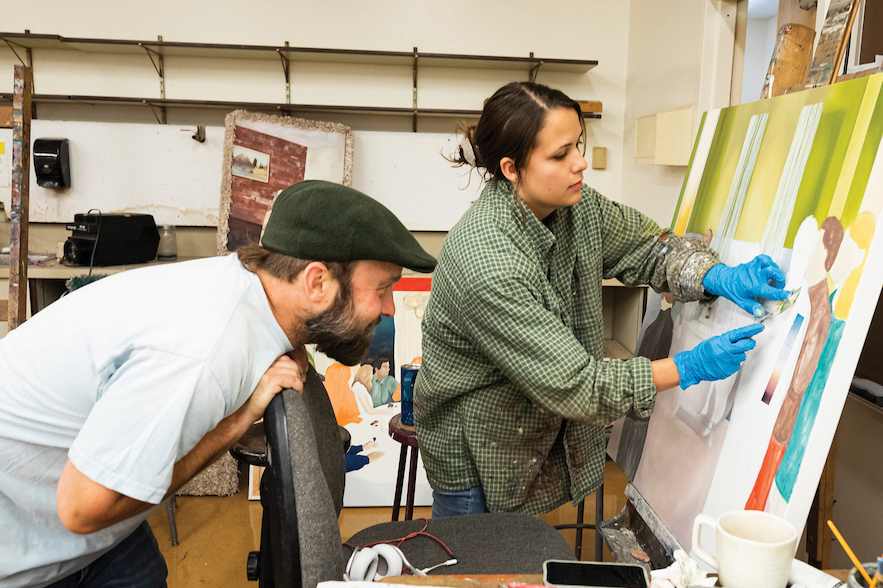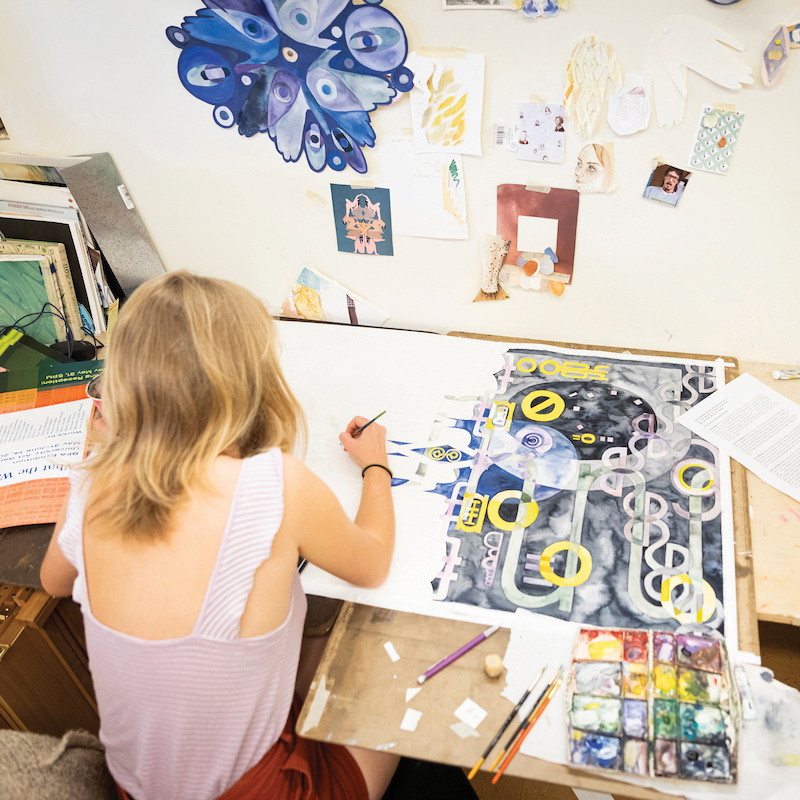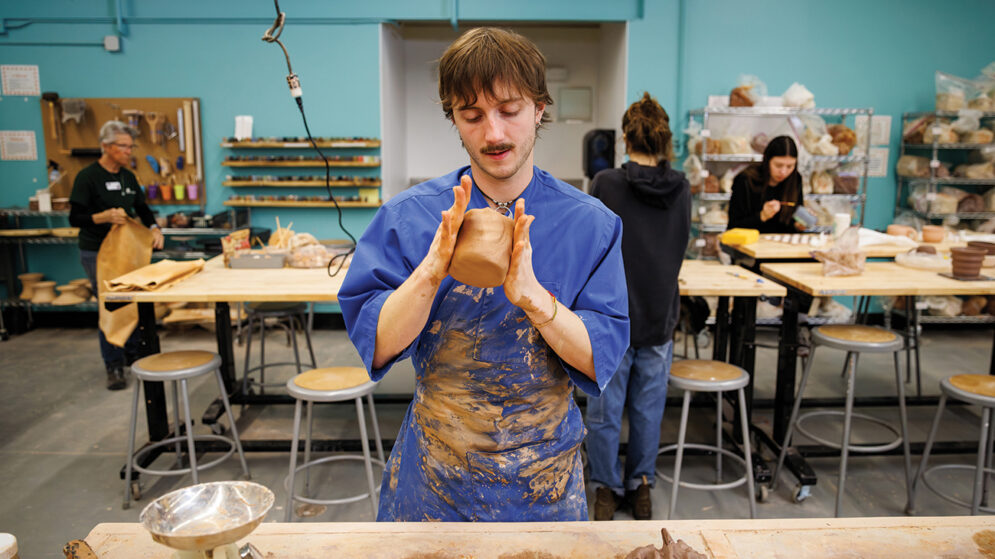Questions & Answers
Why Study Art in a STEM World?
Sara Frantz, chair of the Art and Design Department, speaks about the ways art is integral to the human experience.
Interview by Gabby Ferreira
Share this article:

Sara Frantz poses in her art studio. Photo courtesy of Sara Frantz.
Since the Great Recession, the popular advice for college students has been to pursue a “secure” degree in a STEM field — which has led to declining enrollments in humanities majors. Cal Poly Magazine recently sat down with Sara Frantz, chair of the Art and Design Department, to talk about the importance of art education today.
How did you first get into art, and how did your career path take shape?
Art has always been something I loved and was passionate about, but I didn’t think of it as a career when I was growing up. I love science and thought I wanted to be a vet. But after I got to college, I changed my major from pre-vet to art and design. Through incredibly wonderful relationships with my professors, I learned what it meant to be an art major, an artist and a maker.
I think regardless of what job I had, it would have been something that combined using my brain and making something with my hands. I love to draw and I always came back to that. I think inherently I have this drive to create with my hands that challenges me technique-wise, craft-wise and mentally.
Just like a professor in a scientific field, where there is an expectation of scientific research, my studio practice is that research. I have to be a working, showing, publishing artist in order to keep this job. All of our faculty in this department are working artists. We are not just telling you things in theory. We’re telling you things that we use in practice, because we are also hustling.
Why should people study art?
If art wasn’t necessary, we would have gotten rid of it as a society. Art is a mode of social change, awareness and allyship. I think all of those things are powerful and under attack right now.
But more banally, creativity is embedded in everything we do. The advertisements on your TV, the fashion you’re wearing all involved a creative maker. We are flexible and adaptable people, and it takes adaptable people to notice changes in our culture and society and fill the gaps.
As an artist, you might have an idea like, “Oh, I want to create this sculpture of a woman turning into a bird. How do I do that? What materials do I use to make this happen?”
Then you have to translate the idea visually. It’s an intense deep dive into thinking about how to use materials differently. Having that world open up for you means that you could do really abstract, artistic things. But it also allows you to do incredibly practical things and solve problems.


First photo: A student and faculty member collaborate as a painting takes shape. Photo by Joe Johnston. Second photo: An art student applies shiny metallic tiles to a project. Photo by Brittany App.
Why is it important that we know about and appreciate art?
Art is a way to connect with other people and connect with yourself, and it’s that simple. There’s a reason art therapy is used with children: It’s an avenue for people who might not have the words or understanding to talk about their feelings or their ideas. And it’s a universal, nonlanguage- specific avenue.
A lot of religions throughout history have used the language of art to express, connect, control and create an experience. Think about the famous, massive cathedrals in Europe. The people who built them were trying to create an experience that is closer to God. Catholic masses were originally held in Latin. Who spoke Latin in medieval Europe, let alone could read and write in their own language? But they could go into a cathedral and have a spiritual experience. That’s the power of art.


First photo: A graduating senior works to finish her project for a BFA Show in the University Art Gallery. Second photo: The artist’s color palette. Photos by Joe Johnston.
With the rise of AI in the last few years, what do you think of the relationship between art and AI?
Lots of folks are scared and wondering what will happen in regard to art and design, but this kind of thing is nothing new to artists. For example, when photography was invented, people said it would be the death of painting. Instead, it led to new innovations and abstraction. AI is just the newest and fanciest tool. It will be used like Photoshop or other technical applications to make ideas come to life faster or to open up new media avenues for entry into the arts.
I won’t pretend it’s not a complex issue, and the use of AI raises both ethical and intellectual property questions, but in the most general terms it will be consumed by the arts until it is just part of the machine.
Is there one art class at Cal Poly that you think everyone should try?
I believe everyone should try making art once. Hopefully, in doing so, you have an experience that is both frustrating and enlightening and come out of it with a greater appreciation for how hard it is — and how powerful it is — when it’s done well.
A great place to start would be our general education classes, like the fundamentals of drawing, as well as beginning sculpture and introduction to digital photography or ceramics.
We also offer so many art history classes that are taught by amazing faculty who give you a greater understanding of how art touches everything.
The way our department teaches our GE courses can be summed up this way: wherever you are, we will meet you there and we are going to get better together. You can come in at any skill level, wherever your interest lies, and we will accept you.
Your Next Read
Follow the student cast and crew of Cal Poly’s production of “Clue: The Musical” as they put Learn by Doing on center stage.
Drop by the ASI Craft Center, where busy students can engage their creative side.




